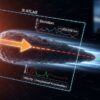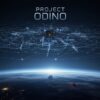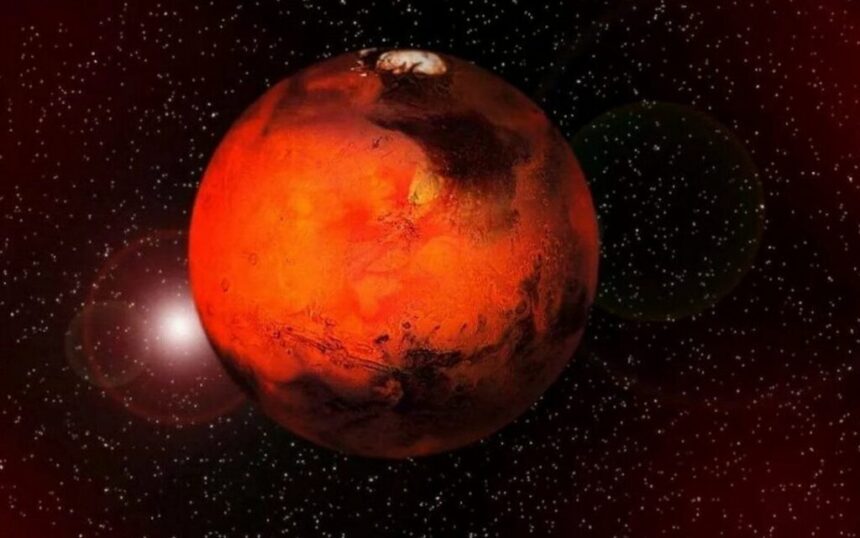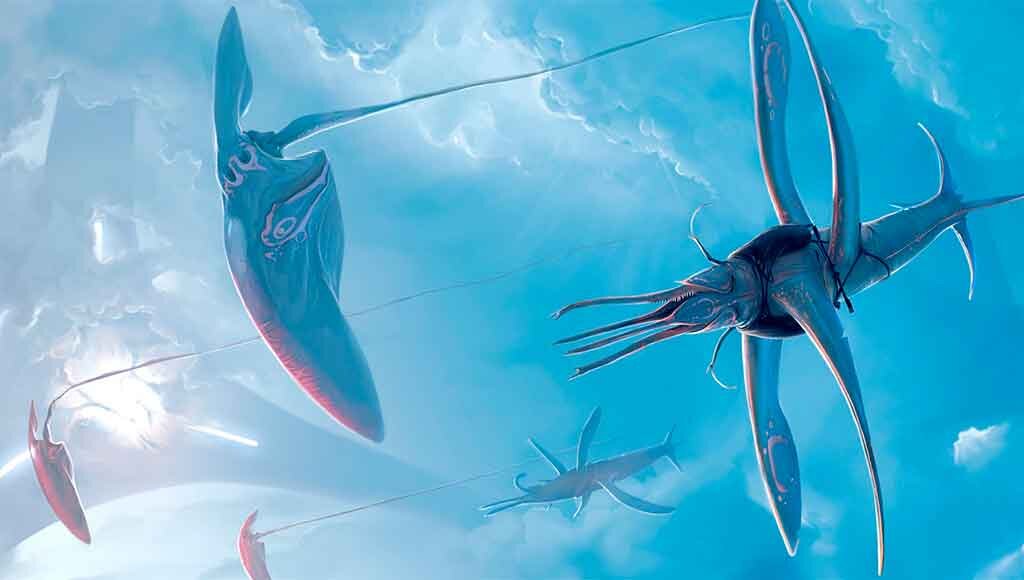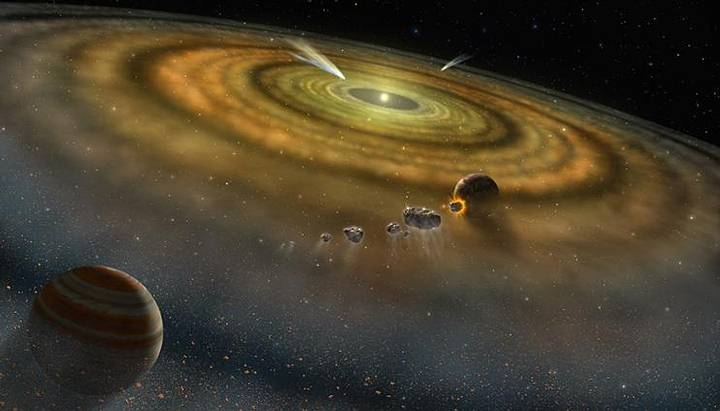For decades, humanity has gazed upon Mars, the enigmatic Red Planet, with a mixture of scientific curiosity and profound wonder. Is it truly a barren, lifeless wasteland, or does its ochre surface conceal a forgotten history, echoes of a vibrant past silenced by an unimaginable catastrophe? While the prevailing scientific consensus points to a planet devoid of extant complex life, a compelling body of visual evidence and intriguing hypotheses challenge this narrative, suggesting a Mars that once teemed with activity, only to be consumed by a cataclysmic event.
Could the desolate landscapes we observe today be the scorched remnants of a once-thriving civilization, obliterated by a devastating conflict? The clues, scattered across vast plains and within ancient crater rims, invite us to look closer, to question what we thought we knew, and to ponder a chilling possibility: Mars was not merely uninhabited, but irrevocably destroyed.
Whispers from the Martian Sands: Architectural Anomalies and Ancient Ruins
The fascination with life on Mars is far from a recent phenomenon. Since the dawn of telescopic observation, whispers of canals and intelligent builders have permeated popular culture. However, with the advent of advanced orbital probes and rovers, these whispers have transformed into concrete, albeit controversial, visual data, sparking renewed debate and fueling the imaginations of both professional scientists and amateur enthusiasts.
The Arabia Terra Enigma: A Geometric Marvel
One of the most captivating pieces of evidence emerged from a 2002 image captured by the Global Mars Surveyor. This photograph, depicting a region known as Arabia Terra, continues to circulate widely on social media, consistently eliciting astonishment. And for good reason. The image clearly outlines what appears to be an artificial structure of remarkably precise geometric design. Spanning an impressive 1500 by 1800 meters, this perfectly flat rectangle suggests the remnants of a colossal foundation or perhaps the eroded walls of a monumental edifice, barely discernible beneath the shifting Martian sands.
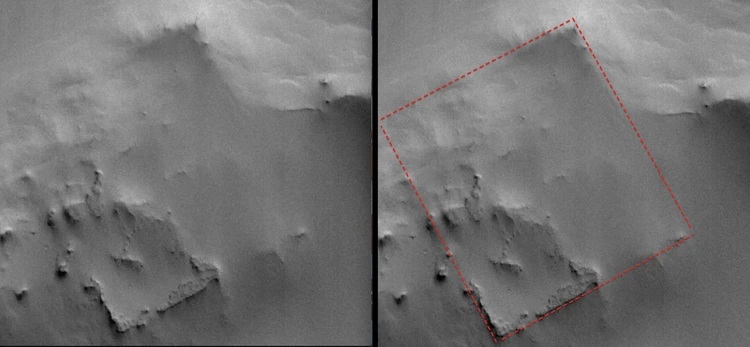
Adding to the intrigue, the lower left corner of this immense structure hints at a protruding feature, eerily reminiscent of an entrance or portal, flanked by what appear to be the weathered remains of columns. While skeptics dismiss these formations as mere pareidolia – the tendency to perceive meaningful patterns in random data – the regularity and scale of these features defy easy explanation through purely natural geological processes. The sheer precision of the rectangular outline strongly suggests an intelligent, deliberate construction, challenging the notion that nature alone could sculpt such a defined form without the intervention of sentient beings. Indeed, it’s plausible that powerful Martian sandstorms, known to rage across the planet’s surface, could periodically expose and re-bury such ancient ruins, offering fleeting glimpses into a buried past.
Atlantis Chaos and Libya Montes: Echoes of Urbanization
Beyond the lone anomaly of Arabia Terra, further photographic evidence from subsequent missions has only deepened the mystery. In 2011, the Mars Reconnaissance Orbiter (MRO) captured images of the Atlantis Chaos region, revealing a bewildering jumble of cellular structures. These formations bear a striking resemblance to the layout of ancient, sprawling settlements found on Earth, particularly those discovered in the deserts of the Middle East. Within this Martian “cityscape,” one can discern what appears to be a distinctive dome-like structure. The parallel to Earth is uncanny; consider the A-Bomb Dome in Hiroshima, a solitary building that miraculously withstood the devastating atomic blast, standing as a stark reminder of a cataclysm.
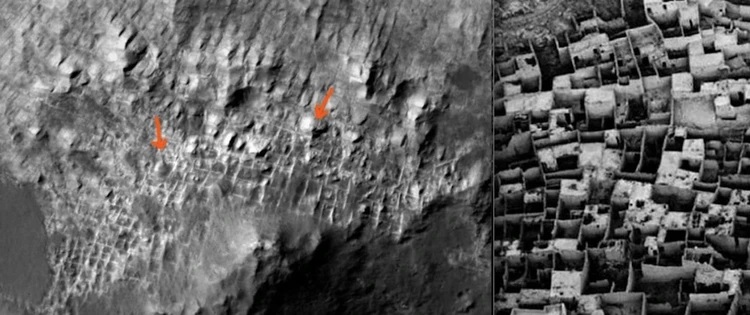
Similarly, images of the Libya Montes area, taken by both the Mars Odyssey and Mars Reconnaissance Orbiter, have prompted scientists to identify what they believe are additional man-made structures. As reported in the Journal of Space Exploration, one particularly striking discovery, dubbed the “keyhole” formation, bears an almost exact resemblance to an ancient Japanese kofun, an artificial burial mound from the 4th century AD.
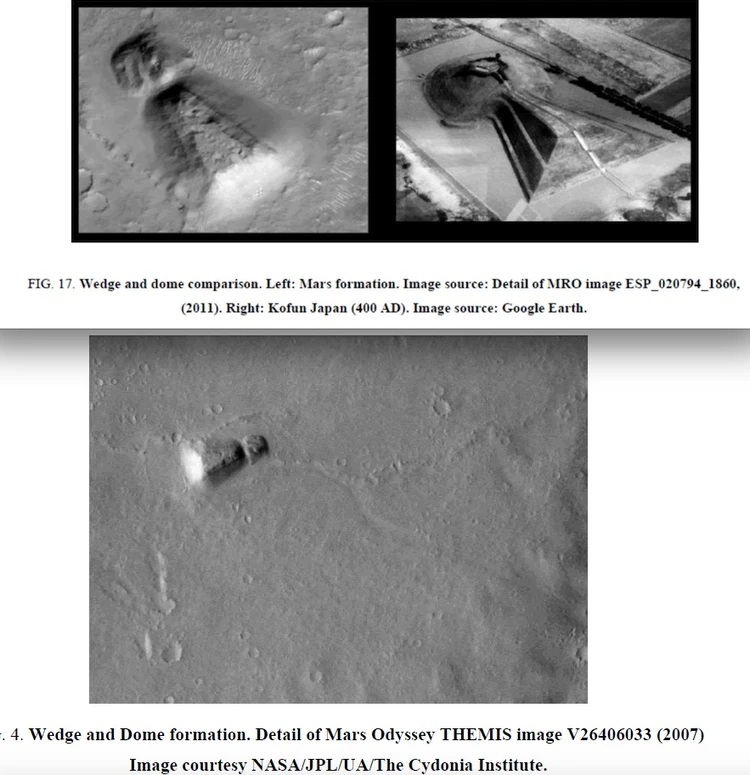
The Martian and Japanese kofuns are remarkably similar in both size and proportion, further blurring the lines between natural geological formations and deliberate, intelligent design.
Ground-Level Discoveries: Skulls, Mummies, and the Unsettling Reality
While orbital images provide a bird’s-eye view of potential ancient structures, the intrepid Martian rovers, operating directly on the planet’s surface, have unearthed even more provocative artifacts, bringing the notion of past life on Mars into stark, unsettling focus.
The Spirit Rover’s Eerie Finds: Martian Skulls
The Spirit rover, during its exploration of the Martian surface, sent back images that have ignited considerable debate: photographs of objects eerily resembling humanoid skulls. One particular object is strikingly white and rounded, with discernible eye sockets and a nasal cavity, its lower jaw partially obscured by sand.
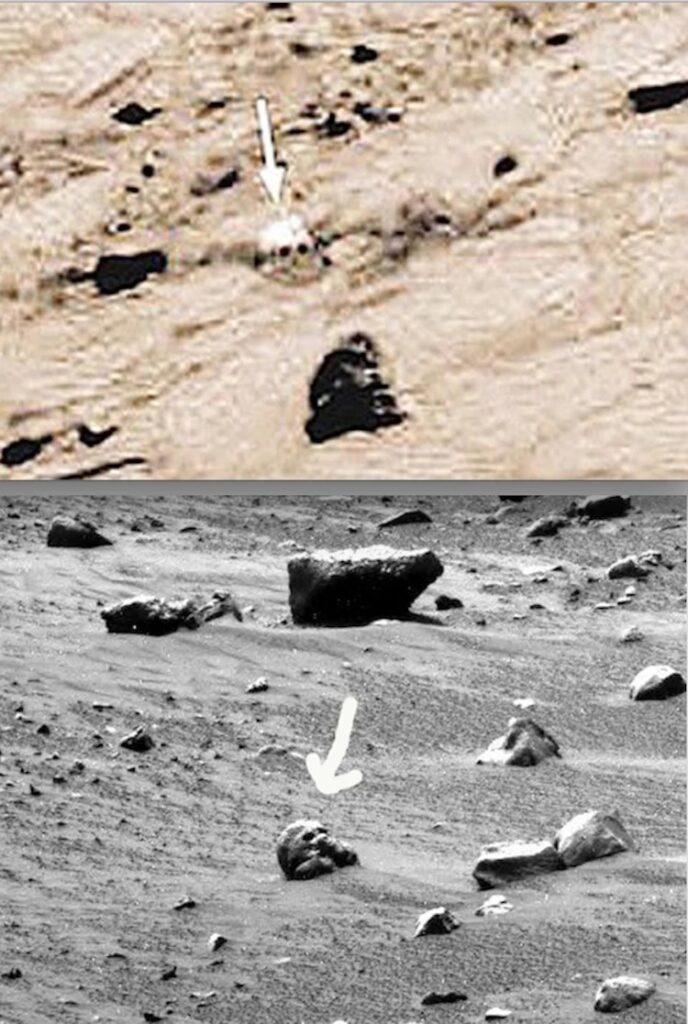
Nearby, another, darker object presents a similar skeletal form. The resemblance to human crania is undeniably striking, leading many to speculate about the nature of the beings that once inhabited Mars.
Curiosity’s Controversial Mummy: A Glimpse of a Fallen Martian
Perhaps the most sensational discovery, and certainly one of the most debated, comes from an image captured by NASA’s Mars rover Curiosity in 2014. Enthusiasts have interpreted this image as the mummified remains of a Martian, a figure that is distinctly humanoid. The alleged mummy exhibits a clearly distinguishable head, an arm, a leg, and even individual fingers on the hand. On the head, what appear to be eye sockets and remnants of hair are visible.
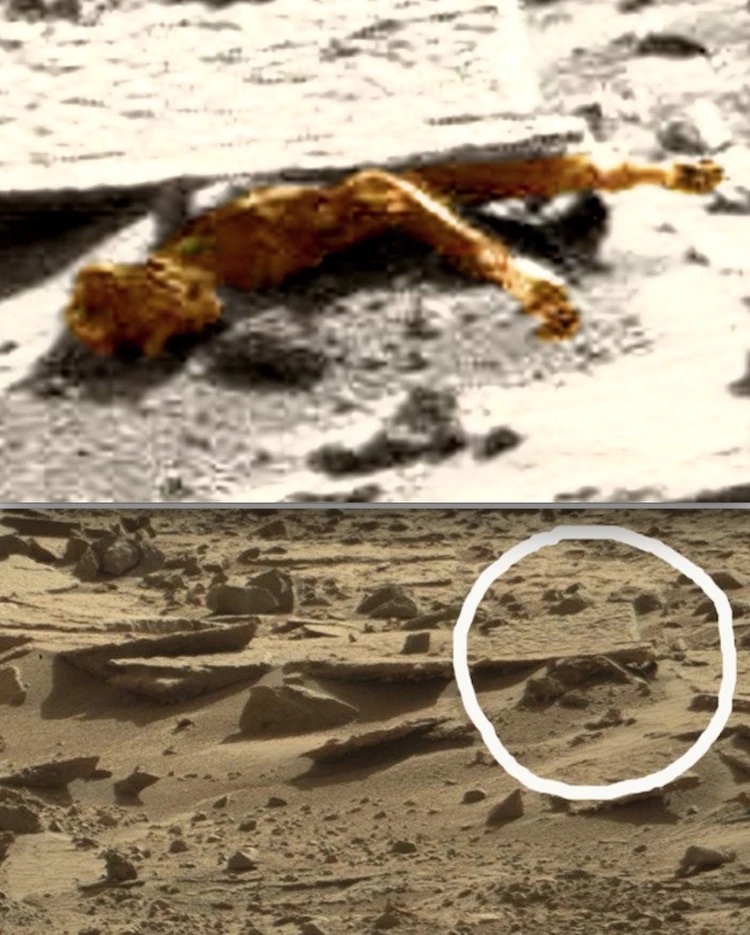
For enhanced clarity, proponents of this interpretation have tinted the original NASA image, further highlighting the alleged features of the mummified Martian. The body appears to be crushed by a large stone slab, suggesting the individual was a victim of a sudden and violent event. The dry Martian climate, it is argued, could have naturally mummified the remains, preserving them for eons.
The Nuclear Winter Hypothesis: A Cataclysmic End
The accumulating visual evidence of potential ruins and remains, while intriguing, begs a monumental question: if intelligent life once thrived on Mars, what became of it? A radical, yet scientifically grounded, hypothesis put forth by Dr. John Brandenburg offers a chilling explanation: a planet-wide thermonuclear war.
Dr. Brandenburg’s Controversial Theory: Evidence of Ancient Nuclear Blasts
Dr. John Brandenburg, a distinguished plasma physicist with a Master’s degree from the University of California, Davis, and extensive experience at the Lawrence Livermore National Laboratory, presented a paper titled “Evidence of Massive Thermonuclear Explosions in Mars Past” at an annual conference of the American Physical Society. Brandenburg is no fringe ufologist; his academic credentials lend significant weight to his provocative claims. He postulates that an ancient Martian civilization was annihilated by an extraterrestrial aggressor.
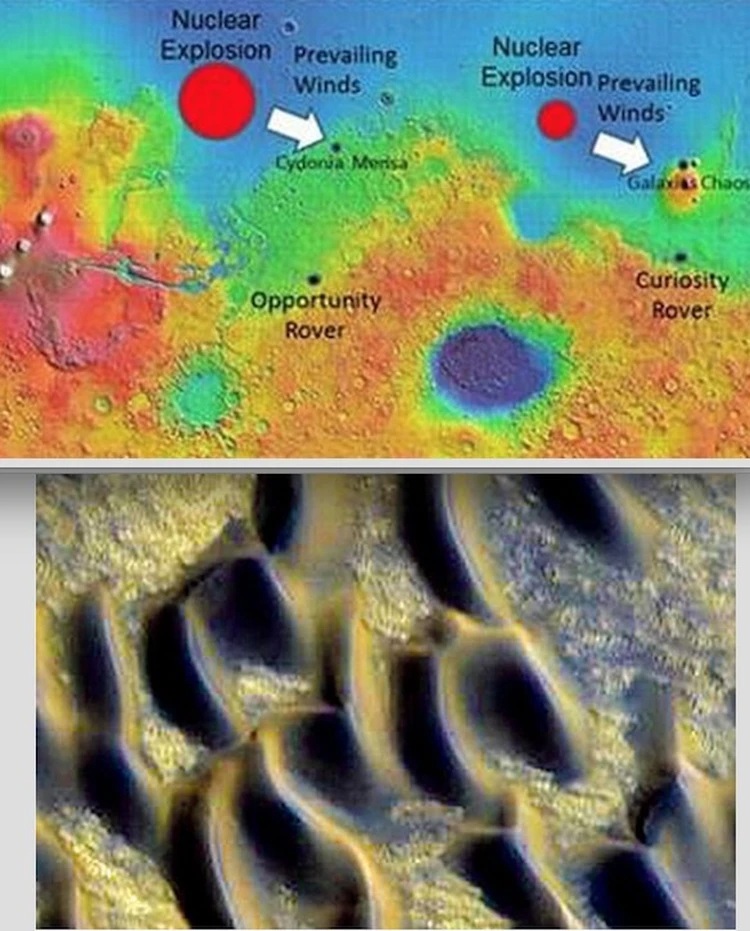
As early as 2011, Brandenburg proposed a hypothesis to explain Mars’ distinctive red hue, suggesting it’s the result of radioactive oxides deposited by incredibly powerful thermonuclear explosions. His theory is supported by the high concentration of xenon-129 in the Martian atmosphere and the presence of uranium and thorium on the surface, detected by the Mars Odyssey spacecraft. These elemental signatures are remarkably similar to those found on Earth after hydrogen bomb tests, hinting at a shared, devastating origin.
Brandenburg speculates that two massive explosions, targeting major centers of Martian civilization in the Cydonia Mensa (home to the famous “Martian Sphinx”) and Galaxias Chaos regions, effectively wiped out all life on the planet. These blasts, he argues, propelled much of the Martian atmosphere into space and caused widespread soil acidification – a Martian equivalent of Hiroshima and Nagasaki, but on an incomparably larger scale.
Vitrified Dunes: The Scars of Thermonuclear Fire
The evidence doesn’t stop there. Vast areas of Mars exhibit what appear to be melted sand dunes, covering an astounding area of over 10 million square kilometers. American geologists Briony Horgan and Jim Bell from Arizona State University reported observing these vitrified dunes in images of Mars’ northern regions, transmitted by the Mars Express probe.
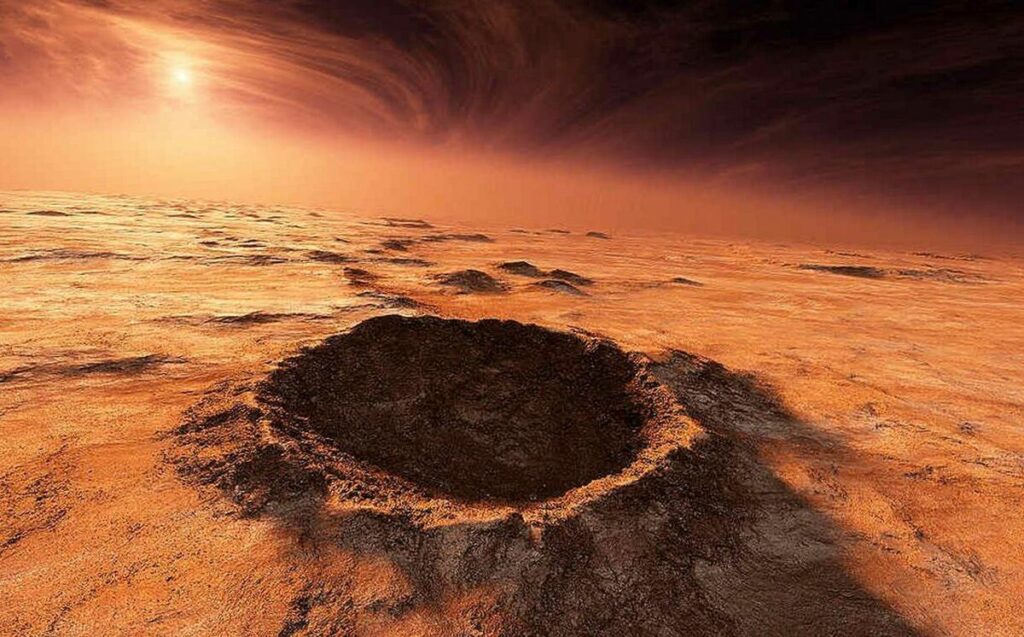
Here again, earthly parallels emerge. Excavations in the late 1970s at Mohenjo-Daro, an ancient city of the Harappan civilization in present-day Pakistan, uncovered extensive areas of melted sand. Enthusiasts believe these areas were vitrified by ancient nuclear explosions. The scale of such an event on Mars, however, would have been vastly more powerful and occurred much earlier – perhaps hundreds of thousands or even millions of years ago.
According to Brandenburg, the Martian civilization at the time of the alien attack was comparable in its developmental stage to ancient Egypt during the era of pyramid construction. The motives for such an attack remain unknown, a chilling void in an already disturbing narrative.
Beyond the Battlefield: The Lingering Questions
To fully embrace the notion of a nuclear war on Mars, instigated by aliens, is, to put it mildly, a significant leap of faith. However, the underlying question persists: was there ever life on Mars at all, in any form?
The Perspective of a Martian Pioneer: Vladimir Perminov’s Insights
To gain a broader perspective, we can turn to “The Difficult Road to Mars,” a 1999 monograph by the esteemed Soviet scientist Vladimir Perminov, Doctor of Technical Sciences and chief designer of deep space vehicles for the Lavochkin Scientific and Production Association, the very architect of the Venus and Mars series automatic stations.
Perminov, reflecting on the findings from early Martian missions, stated, “We did not find obvious traces of intelligent life on Mars, but we saw dried up beds of water streams. What’s wrong? Why did the water disappear? Was there primitive or advanced life in the past? Today we cannot answer these questions. Now Mars seems to be a lifeless desert. On the other hand, we know that in the Earth’s deserts, archaeologists dig up buried ancient cities – many are still hidden under a layer of sand… It cannot be ruled out that in the Martian deserts there may be cities covered with sand. They would be evidence of an ancient Martian civilization that disappeared or moved to other planets…”
Years later, when the Arabia Terra image first surfaced, Perminov, then retired, was contacted for his insights. While he hadn’t specifically hypothesized about buried cities in his book, he remained steadfast in his conviction: “No, I didn’t know about the cities then. But I saw the beds of giant rivers. And he could not give up the idea that there was once water on Mars. Now I am sure that there was life. I don’t know what, at what level. But there was. I hope that people will get to Mars and find at least traces of it…”
The Unanswered Questions and the Ongoing Quest
Perminov’s hopeful words resonate deeply. While humanity has yet to establish a direct presence on Mars, the robotic explorers continue to send back tantalizing data. The “traces” he spoke of, however controversial, continue to emerge, fueling the debate and pushing the boundaries of our understanding.
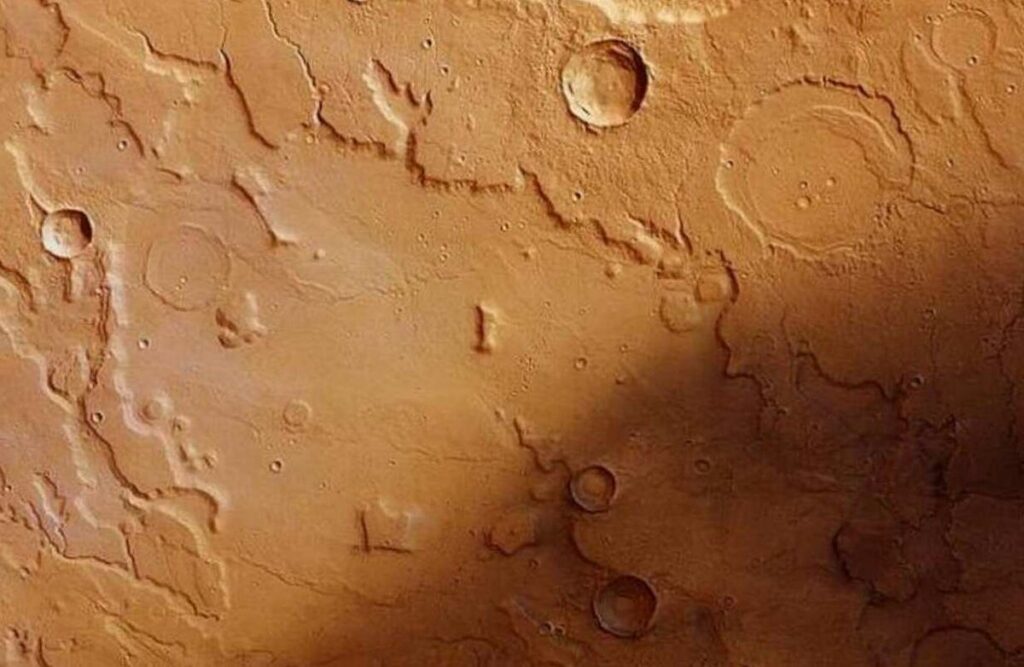
The idea of a lost Martian civilization, destroyed by a catastrophic war, remains a profound challenge to our current scientific paradigms. Yet, the visual evidence, coupled with the intriguing scientific hypotheses, compels us to consider the possibility that Mars is not merely a barren rock, but a planet with a violent, forgotten history. The red dust may conceal not just the remnants of ancient structures and mummified beings, but the silent echoes of a civilization that rose, flourished, and was tragically extinguished, serving as a chilling cosmic cautionary tale for our own fragile existence.
The Lost Planet Phaethon: A Scientific Debate
Even within scientific circles, there’s ongoing debate about the existence of another large planet in our solar system during ancient times, theorized to have orbited between Jupiter and Mars. This enigmatic body has been dubbed “Phaethon.” While little is definitively known about Phaethon, if it indeed existed, certain compelling observations lend credence to its former presence.
Today, the region between Mars and Jupiter is characterized by a vast accumulation of asteroids and various forms of space debris – the asteroid belt. Some researchers propose that this cosmic debris field is, in fact, the shattered remnants of the ancient planet Phaethon. It’s crucial to note that the theory of Phaethon’s existence is not a mere product of speculative journalism; it’s a legitimate scientific hypothesis. Following the discovery of Uranus in 1781, a consortium of 24 astronomers was even formed to locate a “missing” planet, which, based on mathematical predictions, should have resided in that orbital path. However, instead of a single planet, scientists progressively discovered more and more asteroids, eventually realizing that an entire belt of them occupied the expected planetary orbit. Since then, the prevailing opinion among some astronomers has been that these asteroids are the former Phaethon.
The Interplanetary Migration Theory: Why Earth?
If Phaethon existed, and if Mars was once habitable, then a fascinating narrative emerges: that humanity’s ancestors originated on one of these worlds. The destruction of Phaethon, scattering countless asteroids throughout the inner solar system, would have had catastrophic consequences for its celestial neighbor, Mars, which at that time may have been a flourishing, habitable world. The impact events from Phaethon’s demise could have rendered Mars uninhabitable, causing life to flee or perish. If life was present on Phaethon, its destruction would have forced any survivors to seek refuge elsewhere. With Phaethon shattered and Mars devastated, Earth would have been the most viable, perhaps only, sanctuary within our solar system.
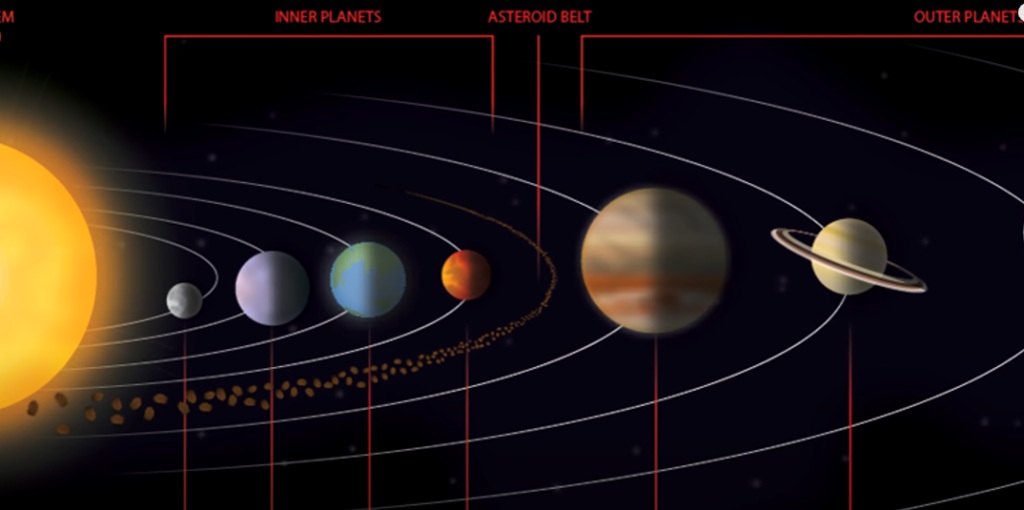
This concept offers a provocative explanation for certain perceived human “disadvantages” on Earth. If humanity originated on another planet, our biological makeup – our bone structure, biological rhythms, the absence of natural defenses like claws, and other characteristics – might have been optimally adapted for vastly different environmental conditions. This could explain why life on Earth often feels so challenging, as if we are not entirely “at home” here. The differences in atmospheric composition and gravitational pull between Earth and a hypothetical homeworld like Phaethon or ancient Mars could account for our physical vulnerabilities. Our superior intellect, compared to other Earth creatures, might not be a product of terrestrial evolution, but rather an inherent trait of a species alien to this planet.
Human Biology: Unsuited for Earth?
Consider the human musculoskeletal system. Many people, even by their 50s, begin to experience significant issues with joints, bones, and cartilage. This rapid degradation could be attributed to our bodies struggling to withstand the constant, unyielding load imposed by Earth’s gravity, suggesting a design not optimized for such conditions. Furthermore, oxygen, while vital for our survival, is also a primary contributor to cellular oxidation and aging. If our ancestral planet had an atmosphere with a higher hydrogen content and slightly less oxygen, our aging process might have been considerably slower. Scientists have identified exoplanets with precisely these atmospheric proportions, where, theoretically, humans could live with much greater comfort. Even water, fundamental to life, in its H2O form, is posited by this theory to have a subtly destructive effect on the human body over prolonged exposure.
Another intriguing anomaly is the human circadian rhythm. Most people find a 24-hour day insufficient to accomplish their tasks and maintain a healthy sleep schedule. A Canadian experiment, where individuals lived in bunkers without external time cues, revealed that their internal biological clocks naturally shifted to a 28-hour cycle within weeks. This aligns with a remarkable finding: models of Phaethon’s trajectory, adjusted for the gravitational influences of neighboring planets, indicate that a day on Phaethon would have lasted approximately 27 hours and 56 minutes. This striking correlation offers compelling, albeit circumstantial, evidence for Phaethon as humanity’s ancestral home.
Current scientific estimates place Phaethon’s destruction around 16 million years ago. Allowing for potential calculation errors, this version of human origin, even from a scientific standpoint, is far from meaningless. The solar system theoretically had three planets within the “life belt”: Earth, Mars, and Phaethon. It is the third planet that researchers increasingly associate with human origin. Traces of oxygen and hydrogen, in proportions consistent with comfortable human habitation, have reportedly been found on fragments of Phaethon in the asteroid belt. The gravitational force on Phaethon was also theoretically less than on Earth, which would have had a beneficial impact on the human body.
A Catastrophe and a New Beginning
Perhaps we didn’t evolve from apes, but instead arrived on Earth as refugees from a planetary catastrophe. Phaethon was destroyed. Mars, facing its own impending doom from the imminent crash of its third moon, which threatened to obliterate its atmosphere, became uninhabitable. Earth remained. If Phaethon’s civilization was caught off guard by the planet’s destruction, only a limited number of survivors might have reached Earth in ancient times, perhaps founding the first civilizations. Alternatively, they might have degraded to a primitive level, with humanity only slowly re-developing over centuries in these new, harsh realities.
Intriguingly, certain ancient myths and narratives bear a striking resemblance to the story of Phaethon’s fall, raising the question of whether these are mere coincidences or fragmented memories of a cataclysmic real history, lost to the mists of time.
Phobos: The Great Lifeboat for Millions of Martians
The Martian moon Phobos remains one of the most enigmatic and “inexplicable” objects in our solar system. In 2015, the European Space Agency, utilizing the MARSIS radar on its Mars Express spacecraft, studied the interior of Phobos. The surprising discovery shared with the world was that “the interior of Phobos appears to be filled with stunning geometrically regular voids!” This revelation profoundly impacts any consideration of Phobos as a potential “lifeboat” for Martians.
Before delving further into the assumption that Phobos could have served as a Martian ark, it’s worth acknowledging the pervasive threat of global cosmic disasters – a topic rarely contemplated in our daily lives, despite corroborating biblical narratives and other ancient accounts. The largest known meteorite crater on Earth measures approximately 500 km in diameter, and there’s a prevailing assumption that Earth’s ancient civilizations held knowledge about the true demise of the Red Planet’s civilization.
It’s undeniable that our civilization will, sooner or later, face existential threats, particularly from the impact of gigantic cosmic bodies. By then, humanity may not possess the means to avert such calamities. Therefore, the following assumptions, however speculative, warrant consideration. One should not outright dismiss the possibility that the supposedly lost Martian civilization managed to survive a catastrophic event. Their survival, perhaps by utilizing Phobos – whose Greek name translates to “Fear” – as a colossal lifeboat, is a compelling, if unproven, notion.
Astronomers are well aware that Phobos is slowly but inexorably spiraling towards Mars, a fact often downplayed to prevent public alarm. Its approach rate is about two meters per century, and this speed is gradually increasing. While this timeframe seems like an eternity from a human perspective, in cosmic terms, it’s a mere blink. Scientific calculations suggest that Phobos will eventually disintegrate in Mars’s orbit in approximately 20-40 million years, forming rings similar to Saturn’s.
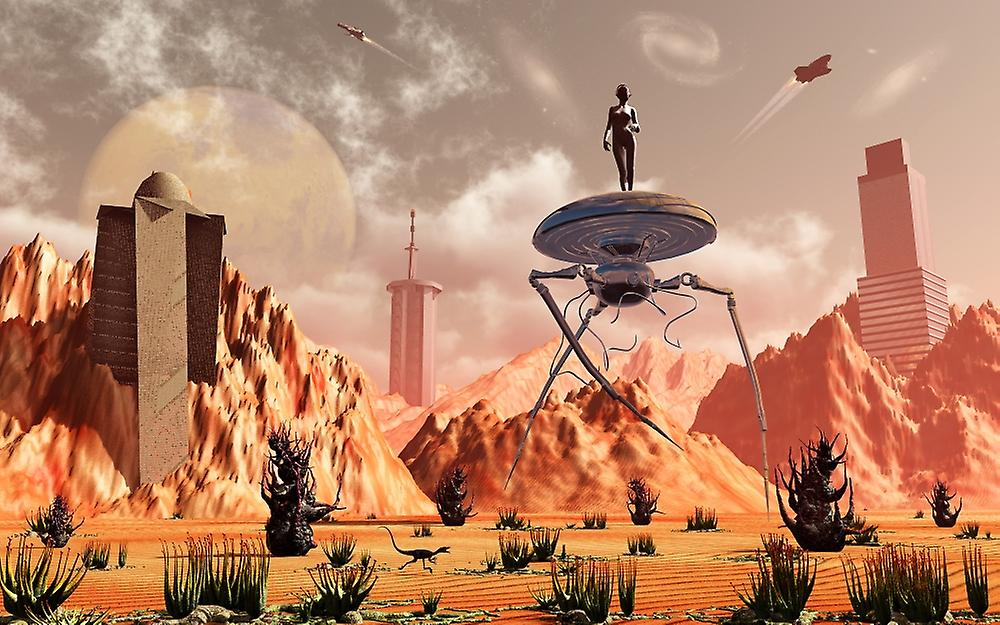
This leads to a profound speculation: could Phobos have been launched into space by the Martians themselves, constructed urgently to escape a predicted catastrophe? Could this colossal vessel have carried an entire Martian civilization, or a significant portion of it, allowing them to survive at a safe distance from the unfolding disaster on their homeworld? It’s plausible that this “boat” sustained the Martian populace for an extended period, too wary to ever return.
Consider the hypothetical scenario: if we received advance warning of a catastrophic event on Earth, our immediate focus would be on rescue options. Mass evacuation into deep space via countless rockets, or even grand colonization schemes like Elon Musk’s vision for Mars, might not be the most practical. Perhaps the Martians, deeply understanding the properties of hydrogen, opted for the rapid construction of a colossal hydrogen airship, built from incredibly strong, yet lightweight, metallic sheets – far superior to anything we currently possess.
This concept envisions an almost 25-kilometer thin-walled structure with a 60-millimeter force shell, akin to visionary designs from the 1960s. This “flying vehicle” would be nearly ten times lighter than Earth’s air but heavier than Martian air, allowing it to lift off the Martian surface and achieve orbit, becoming the very satellite we now call Phobos – implying it’s not a natural moon. Indeed, the theory suggests Phobos is not a natural satellite, nor a “captured asteroid,” but a hollow, gargantuan Martian construct. While no one has yet proposed that Phobos was Martian-built or specifically likened it to a massive hydrogen airship, the geometric voids found within it by MARSIS are highly suggestive.
If such an artificial structure were filled with hydrogen at a pressure of approximately 0.01 atm, even if only 30% of its volume were filled, the hydrogen’s buoyant properties, combined with the centrifugal force generated by Mars’s rotation, could generate a lift force of roughly 16 billion kilograms. This means that, in principle, tens of millions of Martian humanoids could have been transported in comfort from the surface directly to a stationary orbit (at an altitude of 20,392 km) by such an ultralight spacecraft.
Thus, it is conceivable that the entire, or at least a significant portion, of the Martian population could have boarded Phobos on the eve of the predicted catastrophe, ascending to a stationary orbit with considerable comfort. Over time, by replacing the hydrogen with a breathable Martian atmosphere, Phobos could have gradually descended into its current orbit, with the partial appearance of zero gravity inside. The Martians, having accustomed themselves to orbital life, might never have dared to return to the ravaged surface of their home planet.
It is possible that in the very near future, as we further explore Phobos and confirm its artificial nature as a “lifeboat,” our future space endeavors might abandon the use of archaic rockets. It’s more reasonable to assume that such a colossal artificial structure would not serve merely as a lifeboat, but as a heavily modernized natural object – its own moon. By creating metal-lined cavities within this moon and filling them with hydrogen, it could generate reactive force, much like the enigmatic interstellar asteroid Oumuamua. In this context, it’s plausible to envision our predecessors arriving on Earth, perhaps even from Phaethon, and potentially on our own Moon.
The quest for definitive answers continues, urging us to look beyond the obvious, to interpret the subtle clues, and to imagine a Mars far more complex and dramatic than we ever dared to believe.


